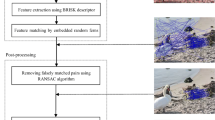Abstract
Copy-move detection is to find the existence of duplicated regions in an image. In this paper, an effective method based on region features is proposed to detect copy-move forgeries, especially when the image is multiple copied or with multiple copy-move groups. Firstly, maximally stable color region detector is applied to extract features, and these features are represented by Zernike moments. Then an improved matching strategy considering n best-matching features is applied to deal with the multiple-copied problem. Moreover, a hierarchical cluster algorithm is developed to estimate transformation matrices and confirm the existence of forgery. Based on these matrices, the duplicated regions can be located at pixel level. Experimental results indicate that the proposed scheme outperforms other similar state-of-the-art techniques.









Similar content being viewed by others
References
Amerini I, Ballan L, Caldelli R, Bimbo AD, Serra G (2011) A SIFT-based forensic method for copy-move attack detection and transformation recovery. IEEE Trans Inf Forensics Secur 6(3):1099–1110
Bay H, Ess A, Tuytelaars T, Gool LV (2008) Speeded up robust features (SURF). Comput Vis Image Underst 110(3):346–359
Chen YH, Huang HC (2015) Coevolutionary genetic watermarking for owner identification. Neural Comput Applic 26(2):291–298
Christlein V, Riess C, Jordan J, Riess C, Angelopoulou E (2012) An evaluation of popular copy-move forgery detection approaches. IEEE Trans Inf Forensics Secur 7(6):1841–1854
Farid H (2009) Photo fakery and forensics. Adv Comput 77:1–55
Farid H (2009) A survey of image forgery detection. Signal Process 26(2):16–25
Fischler MA, Bolles RC (1981) Random sample consensus: a paradigm for model fitting with applications to image analysis and automated cartography. Commun ACM 24(6):381–395
Forssen PE (2007) Maximally stable colour regions for recognition and matching. In: IEEE Conference on computer vision and pattern recognition, Minneapolis, MN, pp 1–8
Fridrich J, Soukal D, Lukas J (2003) Detection of copy-move forgery in digital images. In: Proceeding of digital forensic research workshop, Cleveland, OH, USA, pp 19–23
Ghorbani M, Firouzmand M, Faraahi A (2011) DWT-DCT (QCD) Based copy-move image forgery detection. In: International conference on systems, signals and image processing, Sarajevo, pp 1–4
Hastie T, Tibshirani R, Friedman JH (2003) The elements of statistical learning. Springer
Huang H, Guo W, Zhang Y (2008) Detection of copy-move forgery in digital images using SIFT algorithm. In: IEEE Pacific-asia workshop on computational intelligence and industrial application, vol 2, pp 272–276
Huang Y, Lu W, Sun W, Long D (2011) Improved DCT-based detection of copy-move forgery in images. Forensic Sci Int 206(1-3):178–184
Lowe D (2004) Distinctive image features from scale-invariant keypoints. Int J Comput Vis 60(2):91–110
Mahdian B, Saic S (2007) Detection of copy-move forgery using a method based on blur moment invariants. Forensic Sci Int 171:180–189
Matas J, Chum O, Urba M, Pajdla T (2002) Robust wide baseline stereo from maximally stable extremal regions. In: Proceedings of the 13th British machine vision conference, Cardiff, UK, pp 384–393
Mikolajczyk K, Schmid C (2005) A performance evaluationof local descriptors. IEEE Trans Pattern Anal Mach Intell 27(10):1615–1630
Muja M, Lowe DG (2009) Fast approximate nearest neighbors with automatic algorithm configuration. In: Proceedings of the fourth international conference on computer vision theory and applications, Lisboa, Portugal, pp 331–340
Pan X, Lyu S (2010) Region duplication detection using image feature matching. IEEE Trans Inf Forensics Secur 5(4):857–867
Popescu AC, Farid H (2004) Exposing digital forgeries by detecting duplicated image regions. Tech. Rep., TR2004-515, Dartmouth College, Computer Science
Ryu SJ, Kirchner M, Lee MJ, Lee HK (2013) Rotation invariant localization of duplicated image regions based on zernike moments. IEEE Trans Inf Forensics Secur 8(8):1355–1370
Shieh CS, Huang HC, Wang FH, Pan JS (2003) An embedding algorithm for multiple watermarks. J Inf Sci Eng 19(2):381–395
Shivakumar BL, Baboo S (2011) Detection of region duplication forgery in digital images using SURF. International Journal of Computer Science Issues 8(4):199–205
Teague MR (1980) Image analysis via the general theory of moments. J Opt Soc Am 70(8):920–930
Vedaldi A (2007) An implementation of multi-dimensional maximally stable extremal regions. Tech. rep., University of California, LA (UCLA)
Wazirali R, Chaczko Z (2016) Hyper edge detection with clustering for data hiding. Journal of Information Hiding and Multimedia Signal Processing 7(1):1–10
Zhang ZW, Wu LF, Lai HG, Li HB, Zheng CH (2016) Double reversible watermarking algorithm for image tamper detection. Journal of Information Hiding and Multimedia Signal Processing 7(3):530–542
Author information
Authors and Affiliations
Corresponding author
Additional information
This work is supported by the Natural Science Foundation of Guangdong (No. 2016A030313350), the Special Funds for Science and Technology Development of Guangdong (No. 2016KZ010103), the Fundamental Research Funds for the Central Universities (No. 16LGJC83). This work is supported in part by the National Natural Science Foundation of China (Nos. U1536203 and 61272409).
Rights and permissions
About this article
Cite this article
Li, J., Yang, F., Lu, W. et al. Keypoint-based copy-move detection scheme by adopting MSCRs and improved feature matching. Multimed Tools Appl 76, 20483–20497 (2017). https://doi.org/10.1007/s11042-016-3967-0
Received:
Revised:
Accepted:
Published:
Issue Date:
DOI: https://doi.org/10.1007/s11042-016-3967-0




